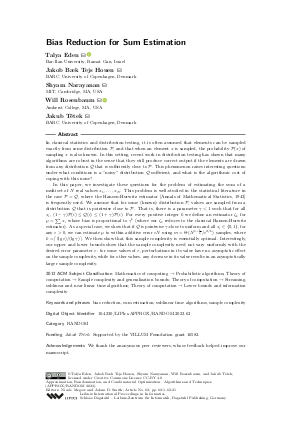@InProceedings{eden_et_al:LIPIcs.APPROX/RANDOM.2023.62,
author = {Eden, Talya and Houen, Jakob B{\ae}k Tejs and Narayanan, Shyam and Rosenbaum, Will and T\v{e}tek, Jakub},
title = {{Bias Reduction for Sum Estimation}},
booktitle = {Approximation, Randomization, and Combinatorial Optimization. Algorithms and Techniques (APPROX/RANDOM 2023)},
pages = {62:1--62:21},
series = {Leibniz International Proceedings in Informatics (LIPIcs)},
ISBN = {978-3-95977-296-9},
ISSN = {1868-8969},
year = {2023},
volume = {275},
editor = {Megow, Nicole and Smith, Adam},
publisher = {Schloss Dagstuhl -- Leibniz-Zentrum f{\"u}r Informatik},
address = {Dagstuhl, Germany},
URL = {https://drops.dagstuhl.de/entities/document/10.4230/LIPIcs.APPROX/RANDOM.2023.62},
URN = {urn:nbn:de:0030-drops-188872},
doi = {10.4230/LIPIcs.APPROX/RANDOM.2023.62},
annote = {Keywords: bias reduction, sum estimation, sublinear time algorithms, sample complexity}
}

 Creative Commons Attribution 4.0 International license
Creative Commons Attribution 4.0 International license









